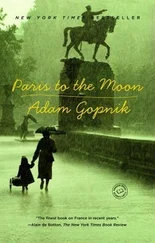Theater lovers put themselves to sleep at night imagining the performances from the past that they would love to have seen: Richard Burbage, say, in the original Hamlet , or David Garrick in the eighteenth-century production. People who love to eat lull themselves thinking about the places where they wish they could have eaten. What would be the five restaurants that a greedy eater would most want to have dined at, but that no longer exist even in ghost form? Maybe the Café Foyot in the nineteenth century, when côtes de veau Foyot had just been invented; Prosper de Montagne, the first of the luxury bistros of the 1920s; or Pyramide in its heyday in the 1950s, with Fernand Point at the stove; or maybe Michel Guérard’s original Pot-au-Feu in the 1970s. (A list to which now will be added, as it closes, Ferran Adrià’ elBulli, in Catalonia.) But certainly Véry in its little temple should be very high on the list of restaurants to dream of.
And, just as the theater lover hesitates, worrying what Garrick or Burbage would have really been like in Hamlet —embarrassingly broad? surprisingly subtle?—greedy eaters worry whether they would have relished or been bemused by a Véry meal. What would we have eaten there? The menus that survive from its contemporaries (I know of none from Véry itself) alternate between dishes that one might make tonight—beef braised in Madeira, garnished with vegetables; grain-fed chicken with crayfish butter—and others that seem to belong to a weird remote past: a sauté of lark filets; filet of partridge in aspic with almond milk and rusks. Doubtless this duality is what we would register at a David Garrick performance, too: if we could go back to any past, we would surely be struck by how past it seems, its best fruits inevitably seeming dried, as seeds of the present we know now. An eighteenth-century Shakespeare performance would surely swing between recognizably sublime moments and weirdly remote rhetorical flourishes; even watching films of early-twentieth-century acting we rock uneasily between Madeira-braised beef and sautéed lark. So, surely, dinner at Véry. We would have been struck, for one thing, by how odd their drinking habits were, with sweet wines offered throughout the meal—sherries and ports. The familiar wet progression—starting with champagne, and then a bottle of white wine, on to red wine, then liqueurs and brandies, ending with a sweet wine—is a late invention, and largely English.
Though something like familiar “French cuisine” would have been found, life in the lewd hanger was, above all, mixed up. And it was the mixing-up in the kitchens, as much as the screwing in the apartments above, that made it lewd. The restaurants at the Palais Royal were, as often as not, what we would now call “ethnic,” not narrowly “French.” The cuisine of the Palais Royal was open. Things poured in. “Wines have been imported from all over the world,” Brillat-Savarin tells us proudly—not a boast that a French food writer would be inclined to make two centuries later—and “French cookery has annexed dishes of foreign extraction, such as curry and the beefsteak and relishes, such as caviar and soy.”
At least two of the most famous and admired restaurants in the Palais Royal were proudly “Provençal”: Les Trois Frères Provençaux—actually run by three brothers from Provence (Maneille, Trouin, and Simon)—and the Boeuf à la Mode, founded by two brothers from Marseille. Both flourished at a time when Provence was as exotic as the Maghreb is now, when familiar dishes such as braised beef and bouillabaisse were what tagines and couscous seem today. That Provence could have contributed to the lewd hanger’s cosmopolitanism, achieved by métissage , strange mixing, shows you how sedate a world the Palais restaurants were shaking up. That braised beef with poached vegetables, still the best of company dishes, should ever have been considered “à la mode,” much less exotic! The secret to its dazzle, then as now, was to add a calf’s foot in the braising liquid, to make it gelatinous. (I remember the odd pride with which my favorite Parisian butcher would include the foot, somehow so white and forlorn, with the roast when you told him what you wanted to make.)
The cosmopolitan current did not flow from Provence alone; when Brillat-Savarin said that a Paris meal could be a cosmopolitan whole, he meant that everything was there. Everyone talked about how many kinds of food you could find—the cuisine of the provinces, of course, Béarn, and the southwest and Burgundy, which kept some of their character as little countries right up to the coming of the railroads and the highways. But still more the cooking and goods of Africa, and America and Asia. “French cooking” was a composite disguised as a whole, an airborne and seaborne thing recast as a shoot from the soil.
Another change that the new restaurants imposed in the 1790s was the abandonment of French or banquet service for what the French themselves called Russian service, which is just what we today think gives order to a meal: instead of a lot of dishes placed nobly on a table with servants to serve them—Carême’s idea of dinner—dishes would come one after another, in an order chosen by the host and his chef. The loss in architectural splendor and arrangement of the kind Carême made great was compensated for by a gain in freedom: once every diner was brought his own dish, soon every diner could choose his own dish.
The passage from French to Russian service turns out, the historian Jean-Louis Flandrin reports, to be a lot more complex than it seems. It took place over time, and, indeed, probably seemed less marked when you experienced it than when you read about it. It is sometimes said that, in the grand French service, the diner’s place at the table determined what he ate: if you were seated down by the beets, beets is all you got. (I have been to New York dinner parties where, seated down among the lesser notables, this was true: you ate what was nearest, and what was nearest was a sign of who you really were.) But in the novels and histories from the period that is not the way people eat at all; what later historians overlook is the superabundance of footmen, ready to help you get the bits you wanted from the other end. One of the hardest things for modern people to keep in mind is the difference between a servant-scarce and a servant-rich environment. Whether the service at the table was Russian service or French service, it was servant service. “It makes a servantless New Yorker sore, to think that Mozart had to bare his head,” Auden wrote once. “But Mozart never had to make his bed.” Servants are to history what dark matter is to the universe: the omnipresent thing that affects everything but that no one quite sees. But surely the change to Russian service was driven, just a little, by fear of footmen, too. “The presence of valets at table is the greatest scourge that can be inflicted on a meal. Their eyes avidly devouring all the dishes, their ears mopping all the opinions, and their tongues always ready to denounce their masters,” the lawyer-turned-bon-vivant Grimod wrote. Even if the threat of betrayal was made melodramatic, the problem was probably really there.
It took time to turn this mixed-up menu into a single ordered enterprise. If the story of the transition from French to Russian service is cloudy, the idea of “French cooking” is truly foggy. Though the idea of “French cuisine” as a systematic enterprise with a single starting point and a neat underlying grammar would spread out to take over the world, French restaurant cooking in 1810 was really a jumble of country food, health food, city food, old chefs from fancy families, and cheap food for hungry people. Only in reading about it later did anyone think of it as old, fixed, and neat as a pin.
Читать дальше












